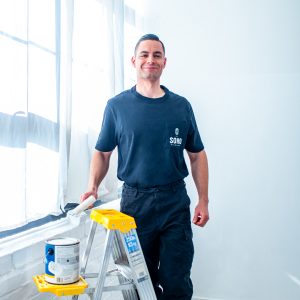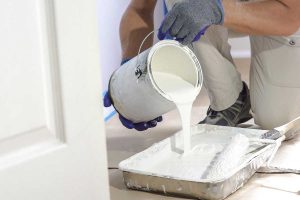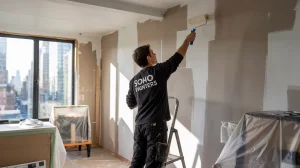If you’ve ever done some painting in your home, you’ve probably come to a situation where you need to paint up to an edge. There are two ways to do this properly: cut in or use painter’s tape. Between the two methods, less experienced DIYers use the second one because cutting in requires an incredibly steady hand to be executed perfectly.
One of the most common questions regarding taping is how long after painting the walls can you tape without ruining the painting job? So in this article, we will not only answer this question but also discuss what taping is and how to tape like a pro.
What is Taping?
Taping is simply a step in painting that prevents spills and ensures clean lines on your painted area. Painter’s tape may come in various sizes– wider ones can provide more protection, while narrow tapes are best used for corners.
Although this seems like a simple task, even the most seemingly minor factors, such as debris and loose dirt on the surface, can potentially cause headaches. Aside from checking the base before taping, one of the most critical factors you need to consider is the timing of your taping process.
How Long Should I Wait Before Taping a Painted Surface?
The short answer is that the painted surface must be left to dry for 24 hours before taping. Depending on the temperature, humidity, and type of paint, this waiting time could even be extended to 48 hours. The point here is that you have to ensure that all parts are completely dry.
If you tape before the paint is ready, there’s a good chance that you will have to fix some damage, thereby wasting time and materials. So don’t rush this step and never tape when the surface is still fresh and wet.
Also, it will be much easier for you to move around, especially in the corners or tight spaces, when the paint is already dry.
How to Use Painter’s Tape
If this is your first time using painter’s tape, follow the easy steps below:
Applying Painter’s Tape
- Keep the surface dry, clean, and dust-free to ensure that the painter’s tape will stick.
- Apply the tape, making sure to press down as you go.
- Again, check that the tape is secured in place by pressing it down firmly using a smooth edge. If you’re painting over a bumpy surface, you might have to press down harder.
- Start painting after applying the painter’s tape.
Removing Painter’s Tape
It is not recommended to remove the tape while the paint is still wet. One reason is that it may create a huge mess. Also, wet paint may seep into the originally taped-off area, therefore defeating the whole point of taping.
Some professionals even wait for 3 days to remove the tape to be absolutely sure that the surface will have a smooth texture and that peeling it won’t leave scratches.
So here are the steps in removing painter’s tape:
- Wait for the paint to fully dry before removing it. Take note of the specified period during which the tape can be removed without much fuss. Many brands have a 14-day removal, which means that it won’t leave a sticky residue as long as you remove it at any time within this period.
- Remove the tape starting on one end and pulling steadily at a 45-degree angle to the painted surface. The edge of the paint should cut through the dried paint overlap, leaving you with a perfectly sharp painted edge.
- If ever the tape tears or won’t pull away, use a utility knife or blade to slice the paint. This will allow you to remove the paint without any problems.
Final Thoughts
While painting can be a rewarding DIY project, it can also be a lot of work and requires a lot of tools and materials. So if you think you’re saving a few bucks by doing it yourself, think again. Mistakes can be costly and may mean that you have to re-do some parts of the job.
If you want to avoid all these stress, hassle, and unnecessary additional expenses, you might want to hire a trusted painting contractor instead. Not only will a professional be able to do it faster than you, but you can also be sure that a reliable one will do it right the first time.
Soho Painters is the most reputable painting company in New York for commercial and residential painting. We also offer a wide range of services, including drywall installation, wallpapering, custom murals, Venetian plaster, and power washing.
So if you have a home improvement project in mind, get in touch with us today, and let’s discuss how we can help you make it happen! We can also provide you with a free quote.





